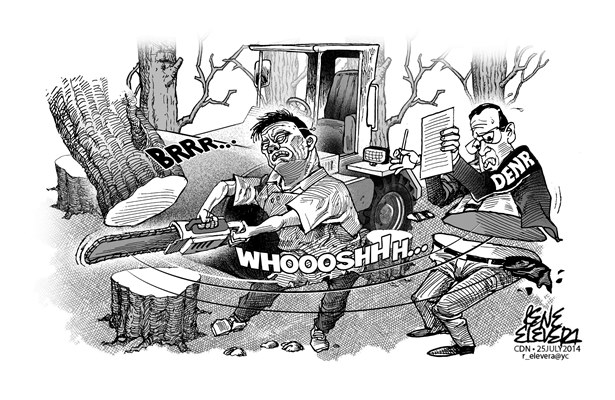The Department of Public Works and Highways (DPWH) was a no-show in last Tuesday’s meeting to discuss the state of ailing trees along the highway of Naga to Carcar in south Cebu where they pose a danger to motorists by suddenly toppling.
The meeting, called by the Department of Environment and Natural Resources (DENR), could be viewed as a pro-active move to address a public safety issue without compromising the state’s policy to protect trees.
The environment department said they had no objection to cutting trees that were weak, old, sickly and could snap any time.
It’s actually happened two weeks ago in Carcar.
An old tree, decayed at the roots and truck, keeled over, blocking access in the main south Cebu highway . It could have maimed a passing motorist, but fortunately no one was injured.
But wait, the DENR can’t just bring in a chain saw and cut the trees down.
For one, the trees stand in the highway easement, which is under the jurisdiction of the DPWH. Secondly, the DENR’s mandate is to protect trees and if these needs to be cut down, it issues permits to earthball them if the trees can still be saved, or cut them down and replant more.
It’s the DPWH’s role now to apply for a special tree cutting permit to replace the one which expired for the Naga project. It’s a simple paper requirement and a matter of inter-agency courtesy.
Look at the hackles raised by DPWH.
Regional Director Ador Canlas scoffed in an interview: “Why do we need a cutting permit?”
He said the road widening project was already finished in Naga with the agency making do with working around the obstacles.
He’s begging the question, showing the familiar mindset of the DPWH which has gained notoriety not just here but nationwide for a huwis-de-kutsilyo approach to dealing with trees as obstructions in their road projects.
Don’t be too quick with the chainsaw, sir.
It bears repeating that trees are valuable not just for beauty but for practical roles of pollution-mitigation, shade, heritage and overal improvement of a landscape that heightens the tourism and cultural value of south Cebu.
The loss of one tree requires replacement with ten or more. Care should also be taken in removing the truly sick trees, and not let demolition crews rip out a series of trees, the way 80 of them disappeared overnight in S. Osmeña Road in Cebu City.
If the DPWH proceeds to chop down trees, there should be responsible adults around to supervise the action. Hence a permit, with accompanying rules of how to remove trees and plant replacements.
Disclaimer: The comments uploaded on this site do not necessarily represent or reflect the views of management and owner of Cebudailynews. We reserve the right to exclude comments that we deem to be inconsistent with our editorial standards.





